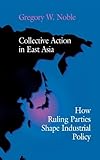Collective Action in East Asia : How Ruling Parties Shape Industrial Policy / Gregory W. Noble.
Material type: TextSeries: Cornell Studies in Political EconomyPublication details: Ithaca, NY : Cornell University Press, (c)2018.Description: 1 online resource : 4 charts/graphsContent type:
TextSeries: Cornell Studies in Political EconomyPublication details: Ithaca, NY : Cornell University Press, (c)2018.Description: 1 online resource : 4 charts/graphsContent type: - text
- computer
- online resource
- 9781501732034
- HC460 .C655 2018
- COPYRIGHT NOT covered - Click this link to request copyright permission: https://lib.ciu.edu/copyright-request-form
| Item type | Current library | Collection | Call number | URL | Status | Date due | Barcode | |
|---|---|---|---|---|---|---|---|---|
 Online Book (LOGIN USING YOUR MY CIU LOGIN AND PASSWORD)
Online Book (LOGIN USING YOUR MY CIU LOGIN AND PASSWORD)
|
G. Allen Fleece Library ONLINE | Non-fiction | HC460.5 (Browse shelf(Opens below)) | Link to resource | Available | on1100435863 |
Browsing G. Allen Fleece Library shelves, Shelving location: ONLINE, Collection: Non-fiction Close shelf browser (Hides shelf browser)
Includes bibliographies and index.
Frontmatter -- Contents -- Acknowledgments -- A Note on Asian Names and Romanization -- Abbreviations -- 1. The Problem of Cooperation in East Asian Industrial Policy -- 2. How Parties and Politics Shape Policy Objectives and Organizational Capacities -- 3. Steel Minimills in japan: The Limitations of Cartels without Effective Compulsion -- 4. Alternatives to Cartels in Taiwan's Minimill Industry -- 5. Standard Setting and R&D Consortia in Japan's Video Industry -- 6. Hapless Standard Setting and Direct Provision of Engineering "Consortia" in Taiwan's Computer Industry -- 7. Extending the Political Logic in Time and Space: Japan, Taiwan, and Korea in the 1990s -- 8. Conclusion -- Notes -- Index
As one Asian economic crisis follows another, sending shock waves through the global market, questions about the making and conduct of industrial policy in the East take on a special urgency. Observers are sharply divided as to whether the ubiquitous attempts at cooperation among competing firms in Asia have been a key to competitiveness or a corrosive form of collusion. This timely book offers a close look at the impact of industrial policies on collective action in East Asia--in Japan and Taiwan and, more briefly, in South Korea. Systematically comparative and based on interviews and original research in the local languages, it focuses on forms of collective action such as cartels, standardization, and research and development consortia in the consumer electronics and minimill steel industries. The book combines detailed case studies with analyses of the political, bureaucratic, and industrial environments in which policy is crafted. It also considers how these environments have evolved in the past decade as long-ruling conservative parties have been challenged in all three countries.Among the book's findings is a surprising disparity between the ways in which Japan and Taiwan have handled collective action policy, despite their many historical, demographic, and economic similarities. Collective Action in East Asia also brings to light unexpected inconsistencies in the effectiveness of Japanese policy, which frequently succeeds with R&D consortia but struggles with cartels. Studying both the rapid-growth period of the 1980s and the more recent economic slowdown in East Asia, this book provides crucial information for an understanding of today's global economy.
COPYRIGHT NOT covered - Click this link to request copyright permission:
There are no comments on this title.






